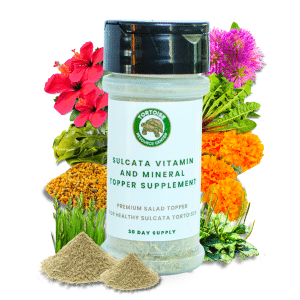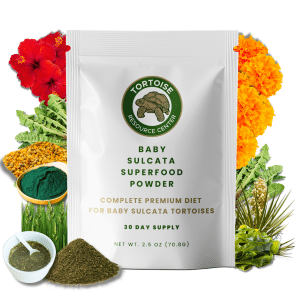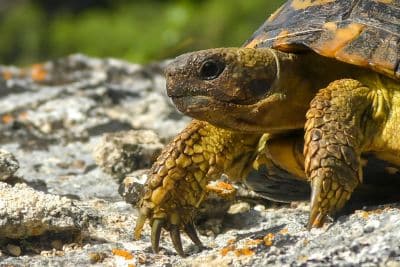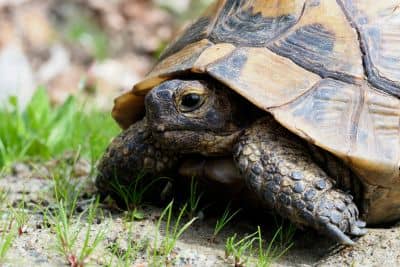The Indian Star Tortoise (Geochelone elegans) is a member of the Testudinidae family and is one of the smaller tortoise species, measuring around 7-12 inches in length, with adult females being larger than males.
Native to the dry areas of India, Sri Lanka, and parts of Pakistan, they thrive in semi-arid, scrubby environments and grasslands. They are accustomed to temperatures of between 80-90°F and have a unique physiological adaptation of being able to withstand extended periods of drought, thanks to their ability to store water and metabolize it slowly.
This species is revered for their striking star-patterned high-domed shell that features black or dark brown, with yellow- or cream-colored radiating lines. This makes them not only visually captivating but also serves as excellent camouflage in their natural surroundings.
Here’s everything you need to know when it comes to understanding Indian Star Tortoise care requirements including diet, habitat, and behavior. All of which are essential to providing a healthy, enriching environment that mimics their natural habitat as closely as possible.
Growth Rate and Life Cycle
Captive Indian Star tortoises can live to 40 or 50 years old. I’ve listed a guide on growth rates below to help track yours.
Expect some differences to occur as they can differ in size slightly. However, any variance that is greater or less than 10% should be monitored in case there is an underlying health issue or environmental problem that needs addressing.
| Life Stage | Length (inches) | Weight (grams) |
| Hatching | 1-2 | 20-25 |
| Juvenile | 2-4 | 30-60 |
| Sub-Adult | 4-6 | 200-700 |
| Adult | 6-12 | 800-3000 |
For hatchlings, you can expect a weight gain of 1-2g every month. This tends to become faster as they grow and begin to eat larger quantities.
Adult male Indian Star tortoises tend to be much smaller in size compared to females. This is largely related to their reproductive roles and behaviors during mating.
Adult females typically measure between 10 to 12 inches in length and weigh between 2.5 to 3kg. Their larger size helps them carry and lay eggs.
Adult males are smaller and more streamlined, which aids in mobility during mating. They average between 6 to 8 inches in length and weigh between 800g to 1.2kg.
Tortoise Enclosures
Only keep Indian Star tortoises outdoors if the climate in your region remains at a year-round temperature of 75 – 95°F. If temperatures dip below 70°F, it’s best to house them indoors permanently, or at least during the cooler months.
You’ll need to cover the bottom of the enclosure with a mix of coconut coir, peat moss, and organic topsoil. The substrate helps to facilitate their natural digging and burrowing behavior and needs to retain some moisture but not get too wet.
You’ll also want to provide a variety of plants and grasses for foraging, and outdoor enclosures will need to be predator-proof, with a secure fence that extends underground to prevent digging escapes.
Whether your tortoise is housed indoors or outside, an adult Indian Star tortoise requires an enclosure that measures at least 4 x its adult shell length by 3 x its adult shell length. For example, if your adult’s shell measures 12” in length, the enclosure should be at least 4ft x 3ft.
Hatchlings require 36’ x 15’ x 15’ with an inch deep layer of bark mulch as substrate.
Environmental Conditions
As primarily diurnal creatures, in their natural habitat, Indian Star tortoises are most active during the early morning and late afternoon, seeking shade during the hottest parts of the day.
For optimal health, you’ll need to create an environment that allows your pet to replicate these behaviors, as follows:
Temperature and Heating
Maintain a basking spot temperature of around 90-95°F, while the rest of the enclosure should be kept between 75-85°F during the day. Nighttime temperatures can drop to around 70-75°F.
If you don’t live in that type of climate, it’s possible to achieve this temperature gradient by installing a heat lamp such as the Lucky Herp 100 Watt UVA+UVB Full Spectrum Vapor Heat Lamp Bulb.
Lighting
For tortoises to metabolize calcium effectively, they need 8-12 hours of UVB light daily either from the sun or from artificial lighting. Without it, they are at risk of poor shell development and metabolic bone disease.
If your region doesn’t get this amount of sunlight, I recommend using the Arcadia Reptile Pro T5 6%UVB 24 Single Lamp Kit.
Humidity
In their natural habitat, humidity levels are high at around 70-80%. Use a hygrometer to monitor levels as you may need to mist the substrate each morning to increase humidity.
Keep substrate moist but not soggy and avoid misting at night when temperatures become lower as this can cause a damp environment that often leads to respiratory infections.
Are You Starving Your Tortoise?
Save 10% on premium tortoise food and supplements from Tortoise Resource Center on Amazon now using code BUYNOWGET10

Sulcata Vitamin & Mineral Topper Supplement
30-Day Supply | 2 oz (56 g)
$24.99

Baby Sulcata Tortoise Superfood Powder
30-Day Supply | 2.5 oz (70.8 g) Bag
$24.99
Hiding Spots and Enrichment
Add objects of interest to your tortoise’s enclosure such as logs and rocks. Hiding spots and shelters are also required to provide security and help reduce stress.
I like to plant non-toxic, live vegetation as this encourages natural foraging behaviors. Just be careful to protect the foots, as these tortoises have a habit of eating the whole plant (including the root) given half a chance.
Diet and Nutrition
In the wild, Indian Star tortoises eat a diet that primarily consists of high-fiber, low-protein, and calcium-rich foods. You’ll need to replicate this for captive tortoises; however, their dietary needs will vary with age and activity level.
Aim for a diet that is 95% grasses such as Bermuda grass, ryegrass, and alfalfa, and Timothy hay. Add in a variety of leafy greens such as dandelion greens, collard greens, mustard greens, turnip greens and endives.
You can also offer vegetables in moderation to provide additional nutrients. Try squash, carrots, pumpkin and flowers including hibiscus, dandelion flowers, roses, and nasturtiums.
Once you get to know your tortoise, you’ll notice that it’ll probably have a few favorite foods that they will likely devour, leaving other items untouched.
The key is to provide variety. I aim for 3-4 different items with each meal and tend to leave the favorite items until after they have eaten everything else or as a special treat.
Hatchings need feeding daily but from sub-adulthood onward, it’s fine to feed them every other day.
I feed mine in the early evening as this mimics their natural feeding habits in the wild. I’ve also started misting gently immediately before feeding as this is thought to stimulate appetite. If nothing else, they seem to benefit from a gentle bathe, and it clears away any debris that’s accumulated around their face during the day.
Foods to Avoid
Oxalate-rich vegetables like spinach, beet greens, and Swiss chard should be limited as they can bind calcium and hinder its absorption. An exception to this is kale. This contains less oxalates and can be offered in moderation.
Avoid feeding your Indian Star tortoise animal protein. They don’t eat it in the wild, is difficult to digest and can cause kidney damage, which in turn may lead to stress.
Fruits should be offered sparingly or not at all. They are high in sugar and can cause digestive issues and diarrhea.
Supplementation
To prevent metabolic bone disease, I recommend dusting their food with a phosphorous free calcium supplement.
This is especially beneficial if you suspect your tortoise is not receiving adequate UVB light and is a must for outdoor-bred tortoises that are housed in-doors during the winter.
Hydration
Make sure your tortoise has access to a shallow dish (a jam jar lid will suffice) full of fresh water for drinking. Although these reptiles originate in climates with long periods of drought, hydration is essential to prevent kidney issues and dehydration.
Health and Wellness
As with most pets, Indian Star tortoises are not exempt from the occasional health issue. In most cases, these will be minor ailments that can be treated by a conscientious keeper – especially if your tortoise came from a reputable captive breeding program.
Issues can arise however, usually through poor husbandry practices, or after illegal importation where they are often housed in less than adequate conditions for prolonged periods of time.
Here’s a list of the most common health issues associated with Indian Star tortoises including symptoms, causes, and treatments for each.
| Health Issue | Symptoms | Causes | Treatment |
| Respiratory Infections | Wheezing, nasal discharge, lethargy, open-mouth breathing. | Poor husbandry, cold and damp environments, stress. | Antibiotics prescribed by a vet, improving habitat conditions. |
| Shell Rot | Soft or discolored patches on the shell, foul odor. | Injuries, poor hygiene, bacterial or fungal infections. | Cleaning the shell, applying antiseptics, providing a dry environment. |
| Parasites | Weight loss, diarrhea, lethargy, visible worms in feces. | Contaminated food or water, poor hygiene, exposure to infected animals. | Deworming medications, improving hygiene, regular fecal exams. |
| Vitamin A Deficiency | Swollen eyes, nasal discharge, lethargy, loss of appetite. | Inadequate diet, lack of vitamin A-rich foods. | Vitamin A supplementation, dietary adjustments. |
| Metabolic Bone Disease (MBD) | Soft or deformed shell, difficulty moving, lethargy, fractures. | Imbalanced diet, lack of calcium or vitamin D3, insufficient UVB exposure. | Calcium and vitamin D3 supplementation, improving diet and UVB exposure. |
I recommend getting your pet tortoise checked out by a veterinary every 6-months. This can help to spot early signs of a problem and mitigate issues later down the line when they become more difficult to treat.
Remember, maintaining good health involves providing a balanced diet rich in leafy greens, and occasional vegetables, while avoiding high-protein foods. Ensure a proper habitat with optimal temperature and humidity levels, and provide a clean, spacious enclosure with access to sunlight or UVB lighting.
Routine Care and Monitoring
In between regular veterinary health checks, you should be performing daily, weekly and monthly tasks to help detect and prevent any early signs of illness and ensure overall well-being.
Daily checks include monitoring your tortoises’ activity. Are they foraging and moving freely between the basking area, cooler spots and hiding places?
If they are constantly hiding away, appear lethargic and / or are uninterested in food, you may need to monitor this for a few days and consider further investigation.
At the end of the day, I make sure to remove any soiled substrate and leftover food, and I replace their water with a fresh supply.
Each week you should be checking for clear eyes, clean nostrils, and healthy shell and skin. Any sign of debris or mucus should be cleaned away and checked again a few days later for any re-occurrence.
At least once per month I will deep clean their enclosure by removing all substrate, sanitizing walls, floors, and enrichment objects with a pet friendly cleaner. I then replenish with fresh substrate.
I also like to weigh my Indian Stars once per month. This applies to hatchings (to monitor their growth and development), and to adults (in case you need to adjust feeding frequency and amounts).
Handling and Behavior Management
Indian Star tortoises often get a bad rap because they are even less fond of being handled than other species.
Don’t be surprised if they retreat into their shell or into a hiding place when you first approach them. Accept that this is normal behavior for tortoises and allow them at least 3-6 months to get familiar with you and their enclosure.
If you minimize any unnecessary handling, loud noises and sudden movements, they will soon begin to get used to you.
After a while, they are likely to respond to your voice and may start walking towards you at mealtimes. The best thing to do is adopt a regular routine so that they become accustomed to having you around at certain times of the day.
Ethics and Legality
Unfortunately, these distinct markings have made them a target to smuggling for the illegal pet and animal parts trade. As a result, they are listed under Appendix I of CITES, and international trade is heavily restricted.
Although this doesn’t make it cruel to own this species of tortoise as a pet, if you are considering one as a pet, find a captive breeding program with a good reputation and who are known for their ethical practices and avoid buying from sources that cannot provide legal documentation or proof of ethical breeding practices.
Alternatively, consider adoption from a rescue organization or wildlife sanctuary. These tortoises are often rescued from illegal trade or unsuitable living conditions and need a good home. Organizations such as the Turtle and Tortoise Preservation Group or the American Tortoise Rescue might be good places to start.
Ethical pet ownership starts with a commitment to conservation efforts and an understanding of the ecological significance. Once you have mastered this, it’s time to get to grips with care requirements.
Citations
- CITES – International trade restrictions for Indian star tortoises
- Turtle and Tortoise Preservation Group – Captive breeding programs
- American Tortoise Rescue – Tortoise rehabilitation and rescue


